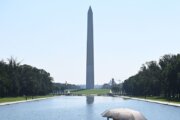This article was republished with permission from WTOP’s news partner InsideNoVa.com. Sign up for InsideNoVa.com’s free email subscription today.
This article was written by WTOP’s news partner InsideNoVa.com and republished with permission. Sign up for InsideNoVa.com’s free email subscription today.
The plans for a commuter ferry taking riders from Woodbridge to Washington are moving forward again after being put on hold due to the COVID-19 pandemic, with a new study on the way that should detail a full understanding of how the proposed system would operate.
The ferry has been under consideration in some form or another for more than 12 years, with a number of crucial details still to be worked out. But the general idea is for a commuter boat to travel on the Potomac River from Woodbridge (possibly from Occoquan or Belmont Bay) to Washington, with stops at the National Harbor in Maryland, Joint Base Anacostia-Bolling and other spots along the riverfront.
Last month, the Northern Virginia Regional Commission reached an agreement with Nelson/Nygaard Consulting Associates to develop a business case analysis for the potential ferry service that could serve as justification for further funding of the project from private investors and the localities involved. The analysis is supposed to be completed by September; afterward the commission hopes to begin discussing funding sources and possible implementation of the project.
The NVRC, composed of all the local governments from the region, has been shepherding the project through its study phase for over a decade and hopes to soon pass it to a governing locality or transit operator in the area for execution.
The idea for the ferry, dubbed the Potomac Fast Ferry, is to keep trip times below what they are during rush-hour traffic, making it a viable alternative to driving that could serve locations that aren’t as accessible by Virginia Railway Express or OmniRide, and to reduce congestion and emissions along the I-95 corridor. There could also be a segment of people riding as a sightseeing attraction.
“It’s no secret that traffic is a problem in Northern Virginia, and one of the untapped resources is the Potomac River. You look at places like New York City, San Francisco and Seattle; they have very successful public ferry systems,” NVRC executive director Robert Lazaro told InsideNoVa. “There’s a lot of people who are interested who see this as an opportunity to get out of their cars and take a boat ride as opposed to a car ride, but you know it’s going to be the finances that either make or break it.”
In 2018, the Potomac & Rappahannock Transportation Commission, which runs OmniRide, applied for a federal grant to operate a pilot project of two daily boats carrying up to 400 passengers each along a route from Occoquan to Joint Base Anacostia-Bolling. That plan was scrapped because VDOT and PRTC didn’t meet the criteria for the grant, but the transit agency still remains involved in discussions on the ferry, as does Prince William County.
OmniRide Executive Director Bob Schneider said it’s possible the bus operator could ultimately run the ferry, but it would depend on exactly what shape it takes.
“Is it just tourism? Is it a tourism-commuter blend? Is it purely a private enterprise? Is it multi-government jurisdiction? Because what we don’t want to do is we don’t want to try to force the proverbial square peg in a round hole,” Schneider told InsideNoVa. “That’s really what the study is designed to do, to answer those questions … and also to recalibrate and re-examine … what are some of the ridership projections and what does it mean in terms of the post-COVID environment, if we ever get there.”
The business analysis is being paid for by the D.C. Department of Transportation and follows two other studies of the ferry, both by Nelson/Nygaard. Those studies found that the route taking ferries north from Woodbridge could draw over 4,000 commuter trips every day, although no formal ridership estimates have been produced for the selected route.
Lazaro said the new analysis will tackle the question of whether the ferry would work best as a public-private partnership, how exactly the final service should operate, and by whom.
“Now is where the proverbial hull meets the water … in terms of how many boats, what the costs are, where they would stop, how many boats they would run,” he added. “It’s a more detailed look on how an operation would work.”
Before any ferries hit the water, a lot of work would need to be done at the various proposed docking stations to prepare them for service, such as expanding parking availability to serve as a sort of park-and-ride, or upgrading the docks themselves to accommodate the increased foot traffic.
Ultimately, Lazaro says, what happens after the business analysis from the NVRC is up to the localities that could be served.
“It’s going to be up to the decision-makers, whether it’s VDOT, the District of Columbia, … [Potomac and Rappahannock Transportation Commission], there’s a whole bunch of entities that would need to take a hard look as to whether or not they want to get into this business or not,” Lazaro said.







